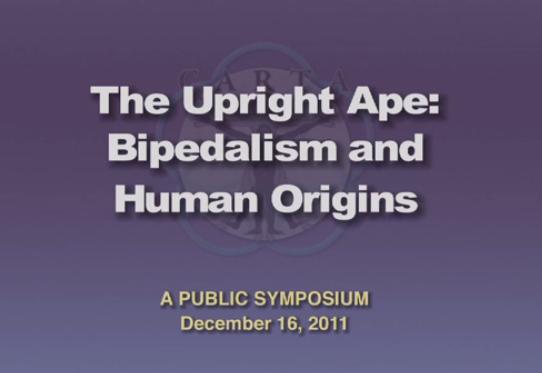The Upright Ape: Bipedalism and Human Origins
Why are we the only two-legged creature to develop an exclusively upright gait? And what did it mean to the development of the human species? The Center for Academic Research and Training in Anthropogeny (CARTA) at UC San Diego brings you foremost experts to explore the many facets of these questions in this fascinating series.
 |
1. Foot and Ankle Diversity in Australopithecus
Jeremy DeSilva shares his insights into the foot and ankle diversity of australopiths and refutes the hypothesis that there is only one kinematic way to be a striding biped.
2. Pelvic Architecture of Australopithecus Sediba and the Genus Homo
Steven Churchill talks about the evolution of the human pelvis and the major architectural changes which reflect an improvement in the ability of this structure to engage in bipedal locomotion.
3. Insights into Hominin Bipedalism from Gorilla Anatomy
Matthew Tocheri shows how the morphology of four foot bones the medial cuneiform, talus, calcaneus, and cuboid is clearly distinguishable among living gorilla taxa in ways that are relevant to interpreting bipedal evolution in hominins.
4. Pleistocene Footprints and the Evolution of Human Bipedalism
Efforts to reconstruct gait and other aspects of behavior in extinct hominins continue to be hampered by disagreements over how to interpret anatomical evidence from the fossil record.
5. Early Hominin Body Form
Carol Ward reviews the growing, although still imperfect, evidence for torso form in apes and early hominins, and relates that to hypotheses about the origins and early evolution of hominin bipedality.
6. Limb Strength Proportions and Locomotion in Early Hominins
Christopher Ruff interprets the analyses of forelimb and hindlimb bone strength in a number of early hominin taxa.
7. The Evolution and Relevance of Human Running
The fastest humans sprint slowly and for very limited durations compared to most quadrupedal mammals, but even average humans have superlative long distance running capabilities in terms of speed and distance compared to other mammals.
8. Bipedalism and the Evolution of the Genus Homo
Leslie Aiello reviews the historical development of ideas in relation to the evolution of bipedality.
9. Body Fat and Bipedality
Matt Cartmill explains the connection between human body fat and bipedality.
| Related Links |
| Walking with Cavemen This is a four-part BBC documentary series narrated by Robert Winston, about the story of human evolution from Australopithecus afarensis to Homo sapiens. |
| Origins of Us This is a BBC documentary series presented by Dr. Alice Roberts, showing how we evolved away from our ape cousins to become the adaptable, successful species we are today. |
| Origins of Us: Human Anatomy and Evolution We are all members of a very special species. Whilst our anatomy and physiology is undoubtedly that of an ape, we have done things that no other ape can do, and become the most successful ape on the planet. |
| Behaviorally Modern Humans: The Origin of Us One of the enduring questions of human origins is when, where and how we Behaviorally Modern Humans emerged and why and how we eventually replaced all the other human-like species. |
| Becoming Human: Unearthing Our Earliest Ancestors This is a three-part NOVA's documentary series investigating the recent discoveries transforming our understanding of our human origins. |
| Prehistoric Autopsy This is a BBC documentary series presented by Professor Alice Roberts and Dr. George McGavin, taking us on an evolutionary journey to meet three of our ancient ancestors - Neanderthals, Homo Erectus, and Lucy. |
| Origins of Genus Homo This explores evidence bearing on the emergence of our genus, focusing on possible antecedents to Homo, changes in diet and body form as Australopithecus evolved toward Homo, ancient species within the genus, and evolutionary processes. |